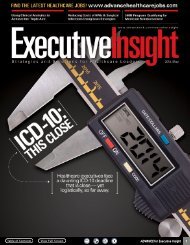INCREASING
Increasing Profitability digital edition - Executive Insight
Increasing Profitability digital edition - Executive Insight
- No tags were found...
You also want an ePaper? Increase the reach of your titles
YUMPU automatically turns print PDFs into web optimized ePapers that Google loves.
1 Executive insight: increasing APRIL 2011 profitability | www.advanceweb.com/ExecutiveInsight<br />
<strong>INCREASING</strong><br />
PROFITABILITY<br />
STRATEGIES TO EXPAND YOUR BUSINESS SCOPE<br />
AND STACK UP FINANCIAL REWARDS.
2 Executive insight: increasing profitability<br />
Executive question & answer<br />
Q:<br />
What was an instance you turned a profit in<br />
a formerly non-profitable area, and how?<br />
Add PROFITS to your BOTTOM LINE<br />
By adding a SUBWAY ® franchise to your facility<br />
Find out what hundreds of hospitals<br />
and medical facilities across<br />
the country already know . . .<br />
Contact Joanne Kilgore<br />
800.888.4848 x 1729<br />
Kilgore_J@subway.com<br />
www.subway.com<br />
SUBWAY ® is a registered trademark of Doctor’s Associates Inc. © 2011 Doctor’s Associates Inc.<br />
➤ Johnny Kuo<br />
Chief Operating Officer,<br />
Gracie Square Hospital, New York, NY<br />
A:<br />
Hospital utilization and services:<br />
inpatient volume, health insurance<br />
benefits, behavioral health programs, community<br />
benefit services.<br />
Hospital utilization is affected by demographics (number<br />
and age of service area population), changes in health<br />
insurance benefits such as growth of managed care,<br />
hospital service capacity, marketing and market share<br />
and area health status. Increasing volume generally helps<br />
performance, since hospitals have fixed costs that are<br />
more easily spread with higher volume. Many community<br />
benefit services are not profitable, but address important<br />
healthcare needs.<br />
➤ Christine Schuster<br />
President and CEO,<br />
Emerson Hospital, Concord, MA<br />
A:<br />
Transitional care unit; keeping<br />
tight control on labor expenses.<br />
➤ Frank Corvino<br />
President and CEO,<br />
Greenwich Hospital, Greenwich, CT<br />
A:<br />
Occupational health; there’s a<br />
market for increased volume<br />
and services to companies.<br />
➤ Amir Dan Rubin<br />
President and CEO,<br />
Stanford Hospital & Clinics, Palo Alto, CA<br />
A:<br />
Improving profit through increased<br />
Medicaid eligibility efforts<br />
(including on-site department of health staff), concurrent<br />
documentation efforts and managed care contract<br />
carve-outs for implants.<br />
SEARCH RELATED ARTICLES<br />
CONTACT THE EDITOR
3<br />
Executive insight: increasing profitability<br />
Reprocessing:<br />
What’s to Fear?<br />
More hospitals are adopting medical device<br />
reprocessing programs. By Cheryl Schwanke, MBA<br />
One of the tenets of environmental efforts is “reuse.”<br />
And more hospitals, looking to save cash and avoid unnecessary<br />
medical waste, are taking this tenet to heart<br />
with medical device reprocessing programs.<br />
The reprocessing industry has experienced steady<br />
growth in recent years, and this trend continues as hospitals<br />
accept reprocessing as an effective way to save cash,<br />
as well as the environment.<br />
More than 3,000 U.S. hospitals have adopted reprocessing<br />
as a standard of care. Moreover, it is not just the<br />
small or physician-employed facilities. The list of those<br />
who use reprocessing programs comprises many of the<br />
top 100 hospitals, as ranked by US News & World Report,<br />
including all of the “honor roll” hospitals and the top 10<br />
cardiovascular hospitals. In addition, leading medical<br />
Cheryl Schwanke is senior marketing<br />
manager for customer retention at SterilMed,<br />
Maple Grove, MN.<br />
Many OR de can be reprocessed as well as EP catheters/cables<br />
and non-invasive devices, including pulse oximeter probes<br />
and compression sleeves. Photo courtesy SterilMed
4<br />
Executive insight: increasing profitability<br />
<br />
Ascent, the medical device reprocessing leader<br />
Regulatory oversight of the reprocessing industry<br />
has further safeguarded reprocessing, especially<br />
since the Medical Device User Fee and Modernization<br />
Act of 2002. This act requires a reprocessor’s<br />
manufacturing, testing and quality processes<br />
be equal to the standards in place by the original<br />
equipment manufacturer.<br />
Highest overall cost savings and<br />
environmental sustainability<br />
Broadest and most efficient service offering<br />
Partnerships with more than half of<br />
U.S. News & World Report “Honor Roll” Hospitals<br />
Advanced supply chain support<br />
organizations support the use of reprocessed devices, including American Academy of<br />
Orthopaedic Surgeons, American Society for Gastrointestinal Endoscopy, Association of<br />
Perioperative Registered Nurses and American College of Surgeons.<br />
Many hospitals only reprocess a small range of devices in the operating room. Common<br />
reprocessed devices include pulse oximeter probes, compression sleeves and trocars.<br />
Since reprocessing has become more widely embraced, the interest in using a wider<br />
range of reprocessed devices has expanded to include items such as laryngeal masks and<br />
external fixation devices.<br />
Reprocessing saves nearly 2.5 million pounds of medical waste from being sent to landfills<br />
each year. A typical 300-bed hospital would divert 35,000 pounds of medical waste from<br />
landfills and reduce device purchase costs up to 50 percent with savings of $410 a bed,<br />
according to Brian Sullivan, President and CEO of SterilMed, a third-party reprocessor.<br />
1.888.888.3433 www.ascenths.com<br />
➤ Why Fear?<br />
Of course, some hospitals and doctors don’t like reprocessing for fear of infection and also<br />
trepidation over possible equipment malfunction.<br />
However, regulatory oversight of the reprocessing industry has further safeguarded reprocessing,<br />
especially since the Medical Device User Fee and Modernization Act of 2002.<br />
This act requires a reprocessor’s manufacturing, testing and quality processes be equal to<br />
the standards in place by the original equipment manufacturer (OEM). This means each reprocessed<br />
device must meet 510(k) standards for cleanliness, functionality and sterility.<br />
Over the past 10 years, third-party companies have reprocessed millions of devices<br />
with no evidence, from any source, of an increased risk to patient safety. As Makary
5<br />
Executive insight: increasing profitability<br />
SterilMed uses microscopic analysis to ensure effective reprocessing.<br />
Photo courtesy SterilMed<br />
et al stated in “A Call to Go Green in Health Care by Reprocessing<br />
Medical Equipment,” which appeared in the<br />
March 2010 issue of Academic Medicine, “the practice<br />
has a reliable safety record of excellence identical to that<br />
of new equipment.”<br />
In addition, a 2008 report by the Government Accountability<br />
Office (GAO) found no evidence to indicate that<br />
reprocessed devices present an elevated health risk to<br />
patients and no evidence linking usage of reprocessed<br />
devices and hospital acquired infections.<br />
In some respects, reprocessors must meet ever stricter<br />
requirements than the OEMs. Since reprocessors will<br />
reprocess some devices several times, the companies<br />
must demonstrate that the device does not degrade during<br />
repeat reprocessing. Thus, each manufacturer needs<br />
to dissemble the device and put it back together, testing<br />
functionality, cleanliness and sterility.<br />
➤ Checking Functionality<br />
Different from OEMs that typically lot test, reprocessing<br />
standards requires that 100 percent of devices be inspected<br />
and tested using customized and FDA-validated<br />
procedures.<br />
Functionality testing processes confirm durability and<br />
functionality after usage and reprocessing. Tests are devicespecific<br />
and include mechanical and electrical tests such as<br />
sharpness, sealing pressure, spring actuation, component<br />
alignment, energy delivery, diagnostic and imaging functionality.<br />
In addition, companies also need to identify and<br />
refurbish device-specific physical degradation and potential<br />
failure modes through reverse engineering. For example,<br />
SterilMed uses computer-controlled equipment to resharpen<br />
orthopedic shavers. It also microscopically hones bladed<br />
trocars and replaces pads for ultrasonic scalpels.<br />
➤ Choosing a Partner<br />
Not all reprocessing partners are the same, so we suggest<br />
using the following criteria when choosing your reprocessing<br />
company.<br />
Device collection. Treating single-use devices like reusables<br />
enhances clinical acceptance while increasing the<br />
percentage of devices yielded from the reprocessing operation.<br />
Higher collections and yield equal fewer devices<br />
sent to the landfills.<br />
Breadth of devices. Ensure your reprocessor has FDA<br />
clearance to reprocess devices for all OR departments, including<br />
cardiology, general surgery, orthopedics, urology<br />
as well as for GI and EP/cath labs. Reprocessed devices<br />
include compression sleeves, pulse oximeter probes, EP<br />
catheters, lap instruments, ultrasonic scalpels, shavers<br />
and blades.<br />
Material flow. Managing inventory is easier if your reprocessed<br />
devices are returned on a regular schedule.<br />
Make sure devices are returned automatically on a prescheduled<br />
basis, typically weekly or bi-weekly, depending<br />
on your facility’s needs.<br />
On-site support. Ensure that your reprocessing partner<br />
offers the necessary field support team, including regularly<br />
scheduled pick-up service, device care and handling<br />
support, as well as clinical in-services. Select a partner<br />
that will help maximize savings by optimizing implementation<br />
and driving continuous improvement.<br />
To analyze the effectiveness of a reprocessing program,<br />
you need to follow the money. Cost savings of programs<br />
are typically measured in dollars per staffed bed and medical<br />
waste diverted from landfills. The more rigorous the<br />
process, the better the cost savings.<br />
SterilMed has increased the savings of current customers<br />
by 15 percent annually over the past five years. For<br />
customers who fully embrace reprocessing, SterilMed<br />
increased savings by an average of 71 percent.<br />
If physicians at your facilities are hesitant to consider<br />
using reprocessed devices, they should meet with reprocessing<br />
company representatives. Also, have them visit<br />
a reprocessor for a tour and demonstration. These experiences<br />
will help alleviate concerns about the safety of<br />
using reprocessed devices and the decision to “reuse”<br />
could save your organization cash in the process.<br />
SEARCH RELATED ARTICLES<br />
CONTACT THE EDITOR
6<br />
Executive insight: increasing profitability<br />
[Part I]<br />
Profitable vs.<br />
Non-Profitable<br />
Some hospital departments are profitable, others less<br />
so. How can you keep the former strong and help the<br />
latter? By Michael Gibbons<br />
In a tumultuous field like healthcare, there are no<br />
givens, especially when it comes to profits and losses.<br />
Can any one department of a hospital qualify as a financial<br />
thoroughbred, a surefire profit-maker? Conversely,<br />
does any one department consistently under-perform<br />
year after year, decade after decade, in all hospitals, in all<br />
demographic areas? Executive Insight wanted to know.<br />
First, we asked our board members to name three reliable<br />
winners and three perennial loss-leaders. Then we<br />
asked two financial consultants the same question. The<br />
results should not only satisfy your curiosity but give you<br />
insights on how you, as a hospital executive, can keep<br />
your gleaming yachts — your winners — sailing in the<br />
right direction and your tugboats, well, help them to reverse<br />
course.<br />
Michael Gibbons is an editor at ADVANCE.
7<br />
Executive insight: increasing profitability<br />
Profit-making<br />
departments<br />
can be doubleedged.<br />
If not<br />
run correctly,<br />
they can all<br />
lose money.<br />
First, let’s look at those departments of a typical metropolitan hospital, if there is such<br />
a thing, that reliably bring in the bucks. These areas make it possible to keep the doors<br />
open, the lights on, the broken arms re-set, the knees replaced and the heart valves unclogged.<br />
Christine Schuster, president and CEO of Emerson Hospital, Concord, MA, told us: orthopedics,<br />
bariatrics and pain management. Nancy Templin, CFO, All Children’s Hospital,<br />
St. Petersburg, FL, offered instead ICUs, cardiac services and neurosciences.<br />
Which three did our consultants choose and why?
8<br />
Executive insight: increasing profitability<br />
Who can give you stability<br />
and momentum at the same time?<br />
B. E. Smith.<br />
When you’re facing an executive vacancy, B. E. Smith can integrate<br />
interim leadership with executive placement to provide immediate<br />
stability today, plus the industry experience you need for the health<br />
of your organization tomorrow. And because B. E. Smith has recently<br />
placed more than 600 executives, we can precisely fit a leader to the<br />
needs of your organization. So it’s no wonder their tenure exceeds the<br />
industry average. To learn more, visit BESmith.com or call 877-802-4593.<br />
Experience. Speed. Results. Guaranteed.<br />
INTERIM LEADERSHIP | EXECUTIVE SEARCH | CONSULTING SOLUTIONS<br />
➤ Double-Edged Departments<br />
Adam Higman, MS, BS had no trouble naming three profit-makers. He tossed in a caveat,<br />
though: if not run correctly, all three can lose money.<br />
“Number one, the OR,” said Higman, a consultant at Soyring Consulting, St. Petersburg,<br />
FL. “Number two, the cath lab. And three, I would say, the ED — less because it brings<br />
in money and more because it brings in lots of patients. Today, EDs can bring in up to 70<br />
percent of total admissions. Many are not just admitted to med/surg units. They are also<br />
getting diagnostics and more profitable services while at your hospital. They may need<br />
surgery.”<br />
Of course, EDs in poor demographic areas, taking in lots of uninsured patients, are not<br />
profitable, Higman acknowledged. “You can’t control that,” he said. “If you’re a hospital in<br />
inner-city Detroit, you are struggling to make a profit even if you run a perfect hospital. If<br />
you’re in metropolitan D.C., it’s much easier.”<br />
On the other hand, EDs with lots of self-paying or well-insured patients might find it easier<br />
to make a profit but must work harder to satisfy those patients. “Well-heeled patients<br />
are usually more demanding,” Higman pointed out.<br />
Cath labs have gained prominence, unfortunately, due to Americans’ fatty diets. “We<br />
are an obese country and more people have heart issues,” Higman noted. “Reimbursement<br />
runs pretty high, historically. But cath labs are also very expensive to run because of<br />
the high-priced products they use and the well-trained people on staff. If they are not run<br />
efficiently, it’s easy to lose money on them.”<br />
➤ Procedure-Oriented<br />
The same question brought some new candidates from Jim Hook, MPH, director of Consulting<br />
Services for The Fox Group, Upland, CA.<br />
“Three traditional areas for profitability are orthopedic, cardiology (especially invasive cardiology)<br />
and neurosurgery,” Hook said. “In the last five to ten years, cancer services have<br />
maybe overtaken neurosurgery as profitable in the eyes of administrators.”<br />
DRG reimbursement and the aging population explain his choices. “They are profitable,<br />
in part, because they are procedure-oriented, especially orthopedics and invasive cardiology,”<br />
he said. “Traditionally, they have relatively high rates of DRG reimbursement.”<br />
The expanding senior population will keep orthopedics profitable in the near term, Hook<br />
predicted. “More people will need knees, hips and various joints replaced and<br />
BESmith_Q211_CEO.indd 1<br />
3/23/11 11:30 AM
9<br />
Executive insight: increasing profitability<br />
Match utilization with staffing in areas such as the OR. ‘You need to<br />
make sure you schedule surgeries wisely so you don’t have these<br />
expensive staff members sitting around. You need to have some<br />
hard conversations with physicians so you have appropriate ratios of<br />
staff members to patients.’ — Adam Higman<br />
will be healthy enough to benefit for a long time from<br />
those interventions,” he said. “Cancer services are coming<br />
on because of a need by aging baby boomers for expanded<br />
services in cancer diagnosis and treatment. Another growth<br />
factor is the availability of better cancer treatments.”<br />
first aid for<br />
equipment financing:<br />
Hands-on support and tenured expertise.<br />
With over 24 years of experience in healthcare equipment financing, we have<br />
our finger on the pulse of your technology and asset needs. Key provides<br />
capital, expertise and flexibility to hospitals and healthcare-related organizations<br />
alike. Which is why our clients look to us for financing solutions to help increase<br />
cash flow, improve efficiencies and enhance their overall profitability.<br />
What sets us apart from other financing providers? Our people. With a<br />
longstanding commitment to equipment leasing, keen understanding of our<br />
clients’ business goals, and dedication to efficient execution, Key offers both<br />
acute and long-term solutions. To learn how equipment financing can help keep<br />
your bottom line healthy, contact us today.<br />
call Stephen Jasiukiewicz at 267-513-1851<br />
email Stephen.J.Jasiukiewicz@key.com<br />
➤ Personnel, Equipment Key to Profits<br />
How can hospitals keep these areas profitable? Focus on<br />
two key priorities, Hook advised: the right personnel, and<br />
the right equipment.<br />
“If you’ve got a superstar orthopedist, he or she may<br />
not be enthused about you recruiting another orthopedist,<br />
but that might be in the best financial<br />
interests of the hospital,” he said. “You need the<br />
right mix of specialties to support these programs.<br />
You can’t have a top-notch cancer program without<br />
a surgical oncologist, a radiation therapist and<br />
a medical oncologist.”<br />
Having the right equipment is critical, too. “You<br />
want to have the best cardiac catheterization and<br />
angiography equipment you can find — with the<br />
qualifier that you want to do an ROI before purchasing,”<br />
Hook said. “You also want to look at supply<br />
costs if you are moving into or expanding into an<br />
area like that. Some hospitals took a real hit when<br />
Medicare reduced its reimbursement for pre-medicated<br />
stents.”<br />
Match utilization with staffing in areas such as the<br />
OR, Higman advised. “Those are highly-paid individuals<br />
in the OR,” he said. “You need to make sure<br />
you schedule surgeries wisely so you don’t have<br />
these expensive staff members sitting around. You need<br />
to have some hard conversations with physicians who<br />
refer and physicians who practice at your facility so you<br />
have appropriate ratios of staff members to patients.”<br />
Also, review your product utilization, Higman continued.<br />
“If you look at specific types of procedures, you might<br />
be losing $40,000 from the types of products you are using,”<br />
he said. “Some procedures may never make you<br />
money because of the nature of reimbursement but, depending<br />
on what your product usage is, focus on how<br />
much capital you expend on products.”<br />
Maintain control over your vendors, particularly providers<br />
of high-priced products, Higman stressed. “Make<br />
sure vendors for expensive items like implants are not<br />
just walking things in the door,” he said. “You need an<br />
approval process, a value-analysis committee in place to<br />
review all products coming in. Does this product make<br />
good clinical sense? Does it make sense in terms of cost<br />
to the facility?”<br />
Dealing with vendors will become even more complex<br />
as hospitals convert to electronic medical records, Hook<br />
added. “A hospital may have many different IT systems<br />
for all its departments,” he said. “One hospital I knew<br />
had 100 different software systems running, all from different<br />
vendors. Finding something to replace all of those<br />
is nearly impossible. Vendors haven’t expanded their offerings<br />
that broadly. It’s a huge challenge.”<br />
SEARCH RELATED ARTICLES<br />
CONTACT THE EDITOR
10 Executive insight: increasing profitability<br />
[Part II]<br />
Profitable vs.<br />
Non-Profi table<br />
Some service lines are chronic loss leaders. Why?<br />
And how can they do better? By Michael Gibbons<br />
In the second part of our examination of hospital<br />
profitability, Executive Insight considers the most fiscally<br />
challenged service lines. Economists use the term “loss<br />
leaders” to denote areas of a company that typically lose<br />
money but are retained for the sake of the reputation and<br />
prestige of that company.<br />
Our editorial board members had several ready examples.<br />
Home care and pediatrics, said Christine Schuster,<br />
president and CEO of Emerson Hospital, of Concord, MA.<br />
Home care, agreed Nancy Templin, CFO of All Children’s<br />
Hospital, St. Petersburg, FL, but also primary care in the<br />
ED, and non-specific med/surg units.<br />
Hospital profitability changed forever in the 1980s,<br />
when DRGs (diagnosis-related groups) were introduced.<br />
Before DRGs, the longer the patient stay, the more money<br />
a hospital made. “DRGs capped reimbursement,<br />
Michael Gibbons is an editor at ADVANCE.
11 Executive insight: increasing profitability<br />
Unlimited<br />
Potential<br />
Why be limited? You need a lot from your MR system.<br />
Doctors demand performance, radiology directors require<br />
up-time, administration wants marketing benefits, and<br />
technologists need application support. Choose Hitachi<br />
and you can get it all with patient-friendly high-field MR,<br />
from Bore-Less Oasis to streamlined Echelon .<br />
Be unlimited.<br />
Echelon<br />
be [unlimited]<br />
Oasis<br />
forcing hospitals to keep a closer eye on LOS (length of service), especially for psych and<br />
long-term care, where patients tend to stay a long time,” noted Adam Higman, MS, BS, a<br />
consultant at Soyring Consulting, St. Petersburg, FL.<br />
That remark revealed two of Higman’s three choices for least profitable areas of a hospital.<br />
“My top three are psychiatric services, where you are definitely losing money, longterm<br />
care, and a newer one: employed physicians, that is, hospitalists, generalists or<br />
specialists employed directly by a facility,” he said.<br />
➤ Poor Reimbursement<br />
Reimbursement for psych services has only gotten worse over the years, according to<br />
Higman.<br />
Psychiatrists have changed their treatment approaches and the government has changed<br />
its reimbursement accordingly. “You really don’t want [psych services] but, in reality, you<br />
can’t get rid of it if you have it,” he said. “It could hurt the image of a community hospital<br />
if it eliminated the only psych services in the community.”<br />
Long-term care, he said, “doesn’t pay as of now, but with the right mix of patients it can<br />
break even.”<br />
And many facilities now employ physicians. The reason is competition: if physicians<br />
work for you, they will use more of your services. But there’s a downside. “A directly employed<br />
physician has no incentive to increase a facility’s patient volume if the facility pays<br />
that physician a fixed salary,” Higman explained. “By contrast, private practice physicians<br />
will see as many patients as they can to maximize their own profits.”<br />
To nd out more about Hitachi and<br />
how together we can be unlimited,<br />
visit www.HitachiMed.com<br />
www.hitachimed.com<br />
➤ Pediatrics, Pregnancy Care<br />
Pediatrics tops the list of financially sluggish service lines for Jim Hook, MPH, director of<br />
Consulting Services for The Fox Group, Upland, CA.<br />
“A great many pediatric departments struggle financially,” he said. “Most pediatric inpatient<br />
care is consolidated into larger hospitals or children’s specialty hospitals. Trying to<br />
operate a pediatric unit in a suburban community hospital is a tough challenge. You may<br />
not get many patients needing inpatient care. Plus, your payer mix is unfavorable, as many<br />
patients are covered by Medicaid.”<br />
Number two is obstetrics. “Payment rates are depressed given the cost of the service,”<br />
he said. “It’s like having surgery, but you are out in one day, so it’s a per-diem payment arrangement.<br />
It’s hard to get the rates for those one- or two-day stays up where they need
12<br />
Executive insight: increasing profitability<br />
to be to break even. Yet it’s hard to raise<br />
your rates adequately to cover your costs<br />
because there is a lot of competition.”<br />
Next comes psych services and EDs,<br />
which Hook called “a mixed bag. EDs are<br />
the single largest source of admissions<br />
but also bring in a lot of people with limited<br />
or no insurance coverage. Standing<br />
alone they can be a problem area finan-<br />
not just getting the worst of the worst.”<br />
For directly employed physicians: Build<br />
appropriate performance incentives into<br />
their contracts. “If you hire hospitalists,<br />
base their incentives on core performance<br />
measures like LOS,” he said. “It’s<br />
better to prolong the contract negotiation<br />
process than, six months down the road,<br />
finding out you’re making a lot less on<br />
“The idea of paying for quality versus<br />
volume will take hold in the next few<br />
years, through ACOs, other partnerships,<br />
and with insurers involved,” he predicted.<br />
“If enough payers offer incentives and increased<br />
reimbursement to organizations<br />
that can demonstrate the quality of care<br />
they are providing, rather than their volume,<br />
that can have a positive impact on<br />
Innovative Egonomic Design Systems<br />
“Quality you can count on from a company you can trust”<br />
cially, yet hospitals couldn’t think of doing<br />
without them.”<br />
➤ Community Support<br />
Higman had several suggestions for improving<br />
the fiscal health of his problem<br />
areas.<br />
For psych services: Find out what safety<br />
nets your community has in place.<br />
“You don’t want to be a non-profit hospital<br />
with no community support, taking<br />
all the losses on that,” he said. “Generally,<br />
there are only one or two psychiatric<br />
facilities serving a large area, so you are<br />
these physicians than you thought you<br />
would. It’s human nature. They need incentives.<br />
So if you are exploring hiring<br />
physicians, you need an idea of what it<br />
takes to at least break even and build<br />
those things into the contract.”<br />
➤ Closing Service Lines<br />
Asked how to fix his problem service<br />
lines, Hook dared to suggest the most<br />
draconian option of all: close them.<br />
“It was a trend in the late 1970s to close<br />
OB services. It’s going on now, too,” he<br />
said. “It’s hard to think how to save mon-<br />
profitability.”<br />
In the meantime, Higman offered a<br />
final bit of advice: focus more on strategic<br />
marketing. “Do your homework,”<br />
he said. “Look at your numbers, your demographics,<br />
your competitors. Figure out<br />
what programs you should be promoting.<br />
Maybe promote yourself as a heart hospital<br />
because there are none nearby and<br />
you have a good heart program that fits<br />
your overall image. Pitch that message to<br />
the community.”<br />
Unlimited Customizavaled Qualit Value<br />
Innovative Egonomic Design Systems<br />
A Division of Star X-Ray Co., Inc.<br />
631-842-3010 Toll-fee in U.S.A.: 1-800-374-2163 www.ieds-inc.com<br />
getting referrals for patients near and far.<br />
The key is making sure you work in partnership<br />
with the community so you are<br />
not a second home for homeless people<br />
or those with psychological problems.”<br />
For long-term care: The more private<br />
pay and well-insured patients you have,<br />
the better, Higman advised, “so make<br />
sure primary care physicians and gerontologists<br />
in your area refer correctly so<br />
you have the right mix of patients and are<br />
ey in the delivery area. People have such<br />
high expectations. OB may remain a loss<br />
leader for the foreseeable future. And administrators<br />
of a community hospital with<br />
a good children’s hospital nearby might<br />
ask themselves why they keep their pediatrics<br />
department open.”<br />
Hook sees a glimmer of hope, though,<br />
in accountable care organizations (ACOs),<br />
a key aspect of last year’s healthcare reform<br />
legislation.<br />
SEARCH RELATED ARTICLES<br />
CONTACT THE EDITOR









